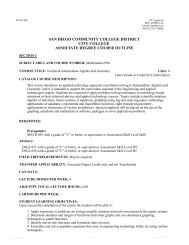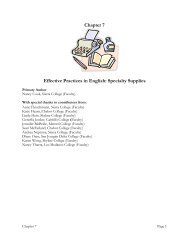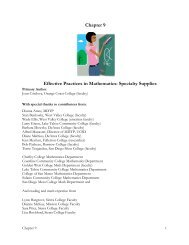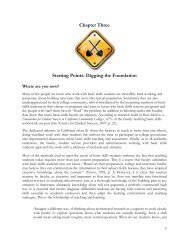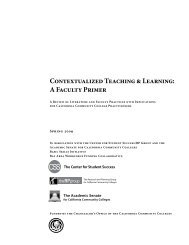CB 21 Rubric Only - Basic Skills Initiative
CB 21 Rubric Only - Basic Skills Initiative
CB 21 Rubric Only - Basic Skills Initiative
Create successful ePaper yourself
Turn your PDF publications into a flip-book with our unique Google optimized e-Paper software.
ESL<br />
Final <strong>Rubric</strong>s for <strong>CB</strong> <strong>21</strong> Coding Updated August 2009<br />
Final English as a Second Language (ESL) Listening and Speaking <strong>Rubric</strong><br />
Listening Speaking Type & Length Listening Speaking Pronunciation<br />
ESL<br />
Listening<br />
and<br />
Speaking<br />
<strong>Rubric</strong><br />
<strong>CB</strong><strong>21</strong> -B<br />
2 levels<br />
prior to<br />
transfer<br />
ESL<br />
Listening<br />
and<br />
Speaking<br />
<strong>Rubric</strong><br />
<strong>CB</strong><strong>21</strong>- C<br />
3 levels<br />
prior to<br />
transfer<br />
Give speeches and participate<br />
in classroom discussions on a<br />
range of topics, which include<br />
informative and argumentative<br />
presentations.<br />
For at least one speech,<br />
presentation or discussion,<br />
incorporate research and/or<br />
secondary sources to support<br />
one’s own opinion.<br />
Speeches are usually less than<br />
5 minutes or longer if done with<br />
partners.<br />
Classroom discussions are<br />
extended and can sustain a<br />
topic for 15-20 minutes or more.<br />
Give speeches and participate<br />
in classroom discussions on<br />
topics ranging from personal to<br />
academic.<br />
May begin to incorporate one or<br />
more sources to augment<br />
information included in the<br />
presentation.<br />
Speeches are about 3-5<br />
minutes.<br />
Classroom discussions require<br />
significant assistance from the<br />
instructor in order to sustain a<br />
topic beyond 10 minutes.<br />
Often understand new information in<br />
sustained personal interactions.<br />
Sometimes understand speech on abstract or<br />
academic topics, especially if there is support.<br />
Demonstrate understanding that is often<br />
affected by length, topic familiarity and<br />
cultural knowledge.<br />
Sometimes understand implications beyond<br />
the surface meaning.<br />
Usually identify subjects and details when<br />
listening to extended speech and rarely<br />
misunderstand the central message.<br />
Take notes focusing on key supporting details<br />
of extended adapted discourse that is<br />
conceptually and linguistically accessible.<br />
Often understand new information in brief<br />
personal interactions.<br />
Demonstrate understanding that is uneven<br />
and generally affected by length, topic<br />
familiarity, and cultural knowledge.<br />
Often identify subjects and details when<br />
listening to extended speech, but sometimes<br />
misunderstand the central message.<br />
Usually understand natural speech when the<br />
situation is familiar or fulfills immediate needs.<br />
Take notes on unfamiliar topics with extra<br />
linguistic support.<br />
Successfully handle most uncomplicated<br />
communicative tasks in social situations.<br />
Initiate, sustain and close a general<br />
conversation with a number of strategies<br />
appropriate to the circumstances and topic.<br />
Use some non-native speaker phrasing.<br />
Be able to connect discourse for a variety of<br />
purposes such as simple narration,<br />
description and reports.<br />
Generally be understood by attentive<br />
listeners.<br />
Have control over many basic and complex<br />
grammatical structures.<br />
Perform basic communication tasks in many social<br />
situations.<br />
Often demonstrate awareness of target culture by<br />
choosing language appropriate to context.<br />
Use basic concrete and abstract vocabulary.<br />
Use a limited range of grammatical structures<br />
correctly.<br />
Maintain a face-to-face conversation on a familiar<br />
topic.<br />
Occasionally express original ideas with limited<br />
grammatically accuracy.<br />
Sometimes use language that is not situational or<br />
culturally appropriate.<br />
Be occasionally misunderstood even by attentive<br />
listeners.<br />
Be usually intelligible<br />
with frequent errors<br />
in pronunciation.<br />
Exhibit some errors<br />
in phonemic and<br />
non-native stress<br />
and intonation<br />
patterns.<br />
Use some nonnative<br />
pauses but<br />
with a near-native<br />
flow so that the<br />
pauses do not<br />
interfere with<br />
intelligibility.<br />
Be generally<br />
intelligible with<br />
significant errors in<br />
pronunciation.<br />
Exhibit frequent<br />
errors in phonemic<br />
and non-native<br />
stress and intonation<br />
patterns.<br />
Use non-native<br />
pauses that<br />
occasionally interfere<br />
with intelligibility.<br />
11



